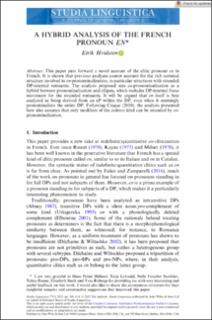| dc.contributor.author | Hvidsten, Eirik | |
| dc.date.accessioned | 2024-02-02T08:01:51Z | |
| dc.date.available | 2024-02-02T08:01:51Z | |
| dc.date.created | 2023-10-13T10:50:27Z | |
| dc.date.issued | 2023 | |
| dc.identifier.issn | 0039-3193 | |
| dc.identifier.uri | https://hdl.handle.net/11250/3115174 | |
| dc.description.abstract | This paper puts forward a novel account of the clitic pronoun en in French. It is shown that previous analyses cannot account for the rich nominal structure involved in en-pronominalization, in particular structures with stranded DP-internal remnants. The analysis proposed sees en-pronominalization as a hybrid between pronominalization and ellipsis, which includes DP-internal focus movement for the stranded remnants. It will be argued that en itself is best analyzed as being derived from an nP within the DP, even when it seemingly pronominalizes the entire DP. Following Cinque (2010), the analysis presented here also assumes that only modifiers of the indirect kind can be stranded by en-pronominalization. | en_US |
| dc.language.iso | eng | en_US |
| dc.publisher | Wiley | en_US |
| dc.rights | Attribution-NonCommercial-NoDerivatives 4.0 Internasjonal | * |
| dc.rights.uri | http://creativecommons.org/licenses/by-nc-nd/4.0/deed.no | * |
| dc.title | A HYBRID ANALYSIS OF THE FRENCH PRONOUN EN* | en_US |
| dc.title.alternative | A HYBRID ANALYSIS OF THE FRENCH PRONOUN EN* | en_US |
| dc.type | Journal article | en_US |
| dc.type | Peer reviewed | en_US |
| dc.description.version | publishedVersion | en_US |
| dc.source.journal | Studia Linguistica | en_US |
| dc.identifier.doi | 10.1111/stul.12216 | |
| dc.identifier.cristin | 2184381 | |
| cristin.ispublished | true | |
| cristin.fulltext | original | |
| cristin.qualitycode | 1 | |

